Scott Hendrix argues that the Reformation was united by an agenda of Christianization. By “Christianization,” he means, first, the effort “to reform the rituals of late-medieval piety in conformity with sound doctrine” and, second, the goal “to create more sincere and intentional believers by transforming people’s minds and hearts” (Recultivating the Vineyard, 148). All branches of the Reformation, including the Catholic, aimed at this same twin goal, though the means and the definitions of “sound doctrine” and sincere belief differed.
This needs to be qualified. One of the strengths of Hendrix’s thesis is his attempt to explain the Reformation in the Reformation’s own terms, rather than framing it in Enlightenment-era categories of secularization and the progress of individual freedom. Yet precisely here the book fails, because the Reformers certainly didn’t see their differences as variations of a common agenda. Luther and Zwingli may have had the same initial intentions, but when they came to an impasse on the real presence, they separated rather sharply. Luther didn’t think Zwingli was carrying on genuine reform with Swiss flavoring; he thought Zwingli was nearly as devilish as the Pope.
Still, from the perspective of Reformation-as-Christianization, Hendrix is able to throw fresh light on the Weberian claim that Protestantism led to a “disenchantment” of the world. He admits that “elements of secularization were present in the Reformation”: “To the extent that Protestants affirmed life in the world over monasticism – the dignity of daily work, domestic roles, and civic responsibility – they enhanced the value of worldly vocations, and without rejecting monasticism Catholics affirmed law vocations as a Christian way of life” (154). But this was not “secularism,” since it didn’t involve discarding “a sacred view of the universe.”
It is also true that “Reformed . . . wanted to eliminate magic and superstition,” but this was an effort to “Christianize” rather than “desacralize,” an effort to remove “what they deemed to be remnants of folk religion that did not belong to historically orthodox teaching, worship, and piety.” Protestants relocated the sacred “from consecrated physical objects to the faithful themselves who were baptized and empowered to live a holy life,” though he admits there were differences between Lutherans and Reformed on this point (154). They aimed to combat “the improper sacralization of Christendom, namely, those practices that reformers considered remnants of paganism or superstitious accretions” (155).
All in all, “the sacred universe of Catholics remained largely untouched, but the faithful were called to personal holiness with an urgency that seemed greater than before. The displacement of the holy from the physical to the personal was not a removal of the sacred from the world but a different way of giving the faithful access to the sacred” (155).
This program was bogged down, slowly and over time, in inter-confessional conflicts. Confessionalization did not, Hendrix argues, mark a new age of history nor a “second reformation” (a term he disputes). Rather, confessional churches initially represented another stage in the effort to install “new forms of Christendom into distinct cultures” (159), a phase of the original Reformation vision of Christianizing Europe. Yet by “the late sixteenth and early seventeenth centuries the competition between Calvinists and Lutherans drew clergy away from the general vision of Christianization that had prevailed in the late Middle Ages and the early Reformation” (159). Preserving confessional purity became the focus more than Christianizing Christendom.
By taking a long view of the Reformation’s Christianizing program, we can better assess its impact, which is not confined to Europe. During the Middle Ages, “Christianity was imposed on traditional cultures from the outside by constructing a unified ecclesiastical structure in the Latin language.” The Reformation introduced a new mission strategy, “more adaptable, vernacular.” On the Protestant mission field, European confessions were “often imposed from the outside . . . but Christianity in Africa has also been assimilated from the inside out, that is, by a process through which Africans spontaneously recognized an affinity between their traditional religions and Christianity. This recognition was facilitated by the translation of Christianity into the vernacular languages of Africa, in contrast to Islam, which has generally insisted upon the sacred nature of Arabic” (163).
Thus, the Christianizing movement began by Martin Luther continues on to the present.














